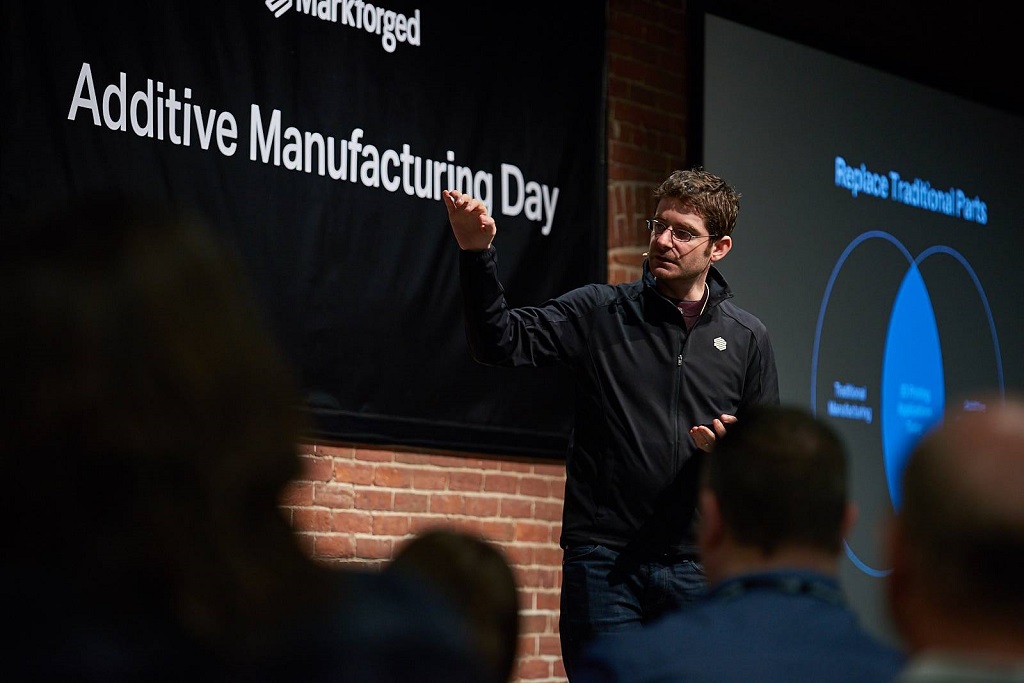![Markforged CEO Greg Mark keynoted Additive Manufacturing Day, discussing the rise of industrial 3D printing [Image: Markforged]](https://fabbaloo.com/wp-content/uploads/2020/05/45076658_2227154753975933_1073135739690024960_o_img_5eb0a3b8f233f.jpg)
Change doesn’t come silently.
During the panel discussion at Additive Manufacturing Day yesterday at Markforged HQ in Watertown, Massachusetts, a common question came up: What’s the coolest thing you’ve seen in additive manufacturing? What’s the coolest application? My fellow panelists shared some great points, and touched on what makes failures interesting, but rather than highlight the “coolest” thing I’ve seen, I noted that the applications that truly speak to me are the ones we can’t see. The GE fuel nozzle came up as a popular example, having been discussed in Markforged CEO Greg Mark’s keynote during the event, and served well to illustrate exactly what I meant. I’ve seen the LEAP engine that houses the showpiece 3D printed component of so much renown, but in the final assembled engine the fuel nozzles themselves are not visible. They’re internal components.
Additive manufacturing is above all – and increasingly with the growing prevalence of viable production capabilities – a manufacturing technology.
It should be boring.
I don’t care, exactly, how my desk chair was made; I care that it holds me when I sit down to work. I began work on this article on my flight back home from Boston; for as much as focus in my line of work is currently on aviation, I still, as a passenger, don’t actually care how this regional jet was made. I care that it works and flies safely to Cleveland. However the parts and pieces of the EMB-145 were manufactured, ultimately I’m glad that this little craft was properly assembled and is well operated. It’s swell, and of great professional interest to me, that increasingly 3D printing is taking its place in aerospace, but when I’m actually flying I just want the plane to work.
We just want additive manufacturing to work.
But until that point, until it’s a tried-and-true mainstay, mainstream technology, we need to keep talking about it.
I say this not (just) as a journalist making a livelihood by talking about 3D printing, but as an observer of both the human condition and the disruption inherent in a digitizing world.
![Markforged CMO Bryan Semple welcoming on-site and virtual attendees to Additive Manufacturing Day [Image: Fabbaloo]](https://fabbaloo.com/wp-content/uploads/2020/05/IMG_20181030_153344_img_5eb0a3ba4f21e.jpg)
Looking back at the first several Industrial Revolutions, it’s apparent from this 21st century perspective how far along we have come in terms of mass production. Assembly lines and electric power are now almost a given when it comes to production-scale manufacturing – but when they were introduced, they were revolutionary. (Hence “Industrial Revolution”.)
Henry Ford had to talk about assembly line work to build the process up when introducing his cars. He is said to have said (or at least we like to attribute the saying to him) that had he asked people what they wanted, they’d have said faster horses; instead he presented the automobile. Which now we also take for granted. Introducing new means of production as well as new means of transportation was no mean feat; it was a process, and one that had to be talked about to spur adoption.
Additive manufacturing is currently in that sweep of adoption. Perhaps from the 22nd century perspective, future generations will look back at 2018 with the same nostalgia with which we look at 1913 assembly lines: So that’s how it began.
Disruption is incremental, process-driven. Part of that process is conversation.
As we discussed during yesterday’s panel, that conversation is already shifting. We’re not talking just about what might become possible, but what is possible. Not just what 3D printing might enable, but how it fits into the manufacturing workflow. And we’re not talking about displacement as part of that disruption; while workflows will shift as additive is integrated into operations, for the most part that will be alongside traditional subtractive and molding technologies as a fuller, more robust manufacturing ecosystem comes to fruition.
“The biggest shift [in the indsutry] that I’ve been seeing, is the conversation. The conversation, during the last two years, has shifted so much toward production. We’re talking about function, we’re talking about safety.” – @SarahGoehrke from @fabbaloo pic.twitter.com/JbdLwrzgDn
— Markforged (@Markforged) October 30, 2018
And until we get to that point of mainstream adoption, we need to keep talking about how to get there, and why.
It’s a similar conversation to any sea change in society. We’re seeing similar conversations in the workplace focusing on the shape of the workforce, for example, as we need to keep talking about the need for and benefits of a diverse and equitable employment force until it’s a conversation that doesn’t need to happen because it is the reality.
We need to talk about progress while it’s in progress. Eventually we’ll have progressed to the point of unseen applications that just work – and are boring.











The 3D printing industry is fast-changing. Sometimes taking a step back, though, is necessary to grasp the bigger picture.